As an Amazon Associate, I earn from qualifying purchases with no additional costs for you.
Sunny days, palm trees, and beautiful beaches are probably the first thoughts that come to mind about Florida, but in addition to its lovely scenery, this state has a treasure trove of colorful rocks and glittering minerals. Take note of these common rocks and minerals that you might find while rockhounding in the Sunshine State.
In the Sunshine State, some common rocks and minerals you can collect are:
- Agatized coral
- Limestone
- Coquina
- Chert
- Staurolite
- Dolomite
- Zircon
- Pyrite
To have a fun and fulfilling rockhounding experience in Florida, it’s best to gather some information about the state’s geology before you arrive. Study up on the common rocks and minerals of Florida, along with their rockhounding locations, using this article.
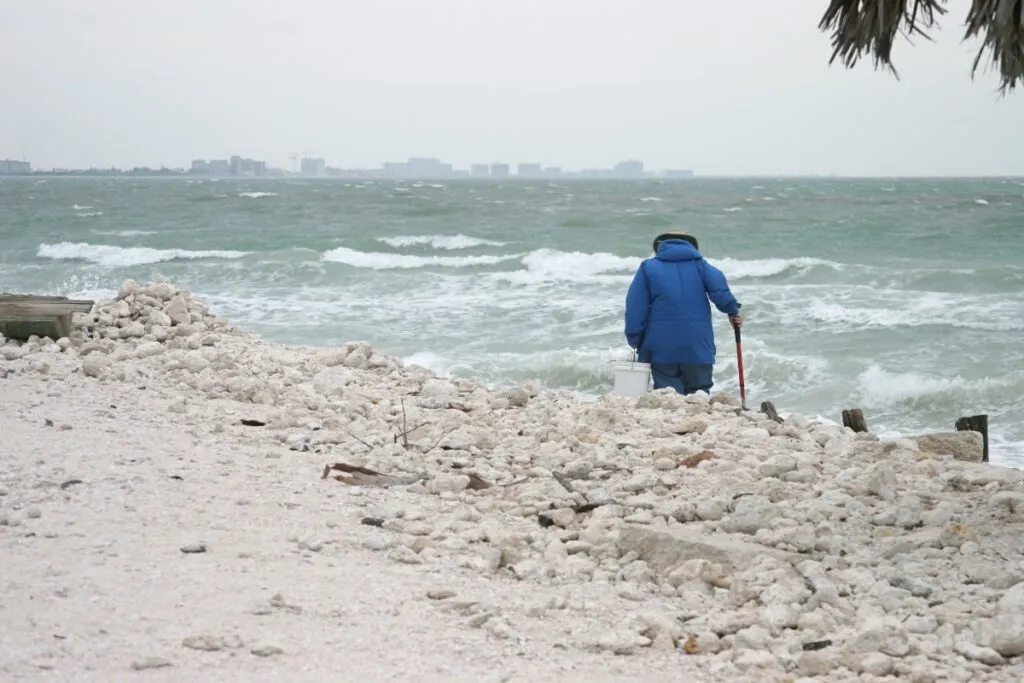
If you are interested in checking out the best rockhounding tools you can find them by clicking here (Amazon link).
What Rocks Are Found in Florida
As you explore the diverse terrain of Florida, keep an eye out for these common rocks:
Agatized Coral
| Location | GPS Coordinates |
|---|---|
| Tampa Bay | 27.914588, -82.531542 |
| Econfina River | 30.205028, -83.746024 |
| Suwannee River | 29.935308, -82.924294 |
| Stephen Foster State Park | 30.312131, -82.749076 |
| Santa Fe River | 29.841045, -82.214124 |
| Ballast Point | 27.887775, -82.481269 |
| Withlacoochee River | 28.648693, -82.278047 |
| Honeymoon Island | 28.070300, -82.829880 |
If you want to add a colorful and unique treasure to your rockhounding collection, you can pick up some agatized coral from Florida. Agatized coral is a mineralized fossil created when agate replaces the minerals in coral, leaving behind shiny, colorful agate along with fossilized coral.
This process of allowing one mineral to replace another occurs without altering the original form of the organism, and the result of this is labeled as a “pseudomorph.”
It takes a significant amount of time for these rocks to form, approximately 20 to 30 million years, so each specimen is at least that old. Florida is one of the few states in the U.S. where you can find this stunning rock, and it was nominated as Florida’s state stone in 1979.
The three places that local Florida rockhounds frequent to find agatized coral are Tampa Bay, the Suwannee/Withlacoochee riverbeds, and the Econfina River. If you aren’t able to travel to these locations, you can also search near Honeymoon Island or the Santa Fe River.
Limestone
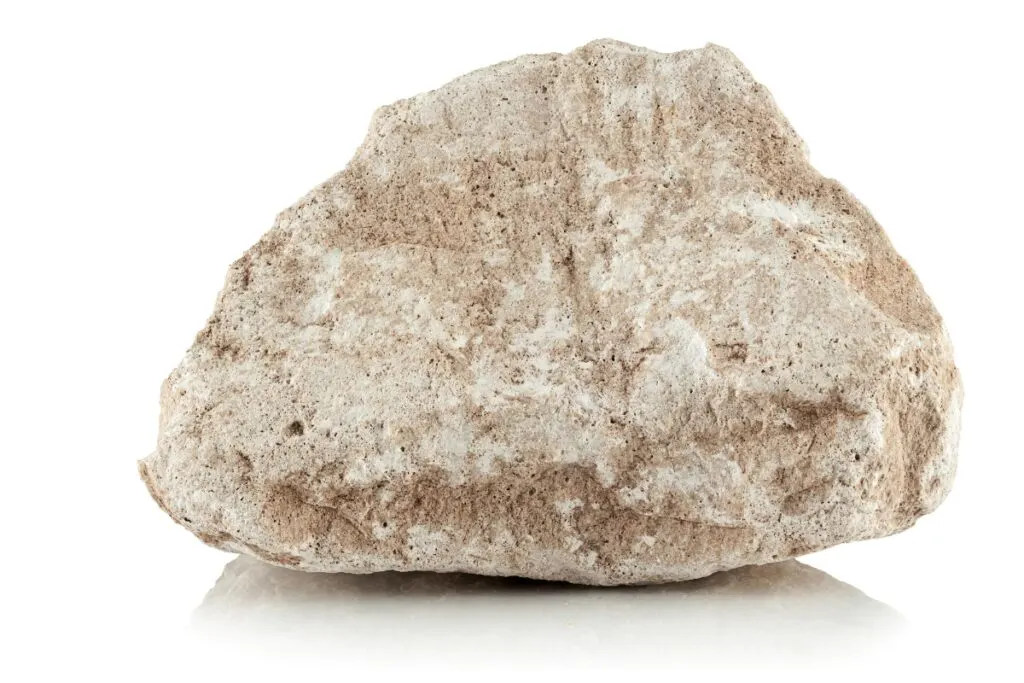
| Location | GPS Coordinates |
|---|---|
| Key Largo | 25.086428, -80.436656 |
| Suwannee River | 29.935308, -82.924294 |
| Ocala | 29.216063, -82.165735 |
| Miami | 25.757341, -80.191010 |
| Marion County | 29.200772, -82.268640 |
| Florida Keys | 24.697265, -81.364770 |
| Broward County | 26.172078, -80.649483 |
As you would expect from a seaside state, Florida has more than enough sedimentary rocks for rockhounds, especially limestone. Limestone in Florida often lies beneath sand and clay, and there are multiple types that you can find.
Some common limestone types in the Sunshine State are Key Largo Limestone, Suwannee Limestone, Ocala Limestone, and Miami Limestone, all conveniently named after the region where they are found.
Key Largo Limestone is light gray and often contains coral fossils, while Suwannee Limestone is a pure limestone that contains a high percentage of calcium carbonate.
Ocala limestone is similar to Suwannee limestone except that it is composed of calcium carbonate that’s almost completely pure and nothing else. Finally, Miami Limestone is made of ooliths, quartz, and fossils.
Key Largo, the Suwannee River, Ocala, and Miami are excellent locations for Florida limestone, but rockhounds also search near Marion County, the center of Florida’s limestone production. The Florida Keys are also made of limestone, so the islands are great places to look.
Recommendation box: All tools and equipment you need for rockhounding and rock identification* (Amazon links):
1. Estwing Rock Hammer – Light, comfortable, and extremely durable hammer.
2. Estwing Geologist Pick – Classic and the most trusted paleo pick in the world.
3. Finder 12-inch Chisels – Heavy-duty chisels set with hand protection.
4. Mini Handle Shovel – This is a great tool for digging deep in the dirt.
5 Ironclad Utility Work Gloves – Breathable, but they also protect the areas requiring them most.
6. 3M Safety Glasses – Comfortable and efficient goggles for rockhounding.
7. Convoy 8+ UV Light – 365nm UV LED flashlight with a patented glass filter.
8. Wesley’s Jewelers Loupe – High magnification options (30X and 60X) with carrying case.
9. Mohs Hardness Kit – A specially designed kit for rockhounds
*All recommended products are personally tested and regularly used by experts from this website.
Coquina
| Location | GPS Coordinates |
|---|---|
| Washington Oaks State Park | 29.633577, -81.204903 |
| Palm Beach County | 26.453827, -80.253086 |
| Coquina Beach | 27.447875, -82.692078 |
| St Augustine Beach | 29.843518, -81.265007 |
| St Johns County | 30.082357, -81.446794 |
| Flagler County | 29.596340, -81.195482 |
| Flagler Beach | 29.462510, -81.133684 |
One rock in Florida with an interesting texture and appearance is coquina, a sedimentary rock made almost entirely of marine fossil fragments.
This rock is considered to be a type of limestone, and it has a distinct porous appearance. The name coquina is Spanish for “tiny shell,” fitting for a rock composed of tiny shells and fossil pieces.
Fortunately, Florida’s beaches possess gorgeous coquina, so be sure to stop by St Augustine Beach or Flagler Beach during your travels.
Chert
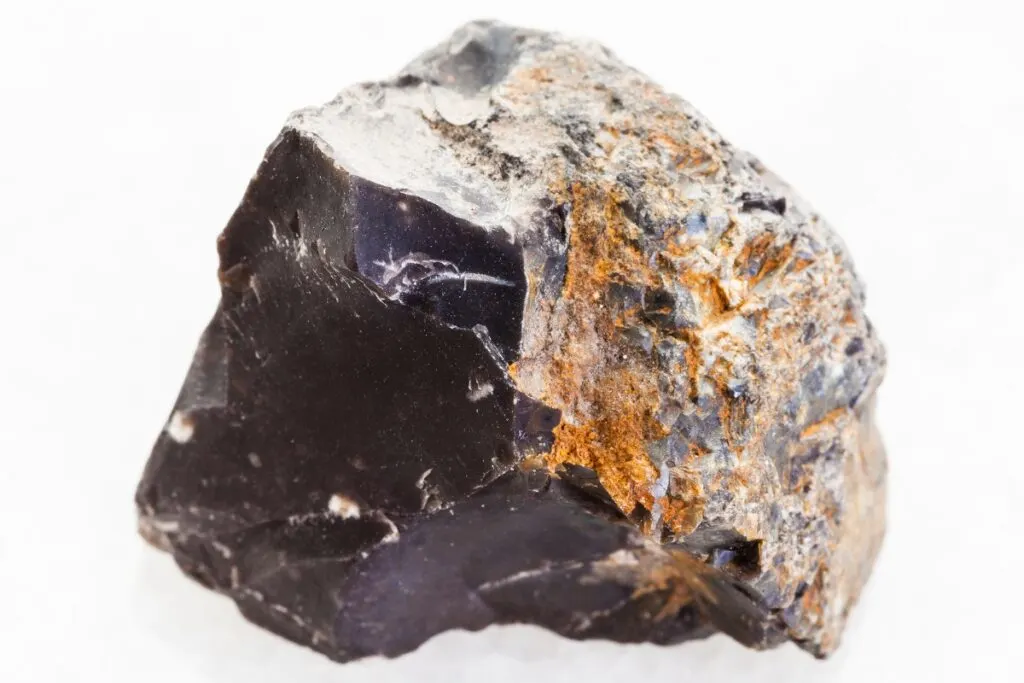
| Location | GPS Coordinates |
|---|---|
| Ocala | 29.216063, -82.165735 |
| Cottondale | 30.796666, -85.376238 |
| Chipley | 30.783100, -85.535811 |
| Suwannee River | 29.935308, -82.924294 |
| Jackson County | 30.807911, -85.163203 |
| Washington County | 30.637013, -85.721916 |
| Marion County | 29.200772, -82.268640 |
Centuries ago, Florida natives used chert to manufacture axes, spearheads, arrowpoints, and other tools for survival.
Chert is generally gray, but Florida varieties come in orange, red, blue, and yellow shades. Flint is a type of chert that’s common in the Sunshine State, and it’s usually found with limestone or dolomite.
The best places to find chert in Florida are Ocala, Cottondale, and Marion. If you are searching for red chert specifically, the streams in Cottondale should be your first stop.
TIP: Let’s see exactly how chert forms, where you can find it, and what state is the best for finding chert specimens in the article below:
Where to Find Chert: Best Environments & Locations (USA)
What Minerals Are Found in Florida
Florida has plenty of shiny and unique minerals for rockhounds to discover, such as:
Staurolite
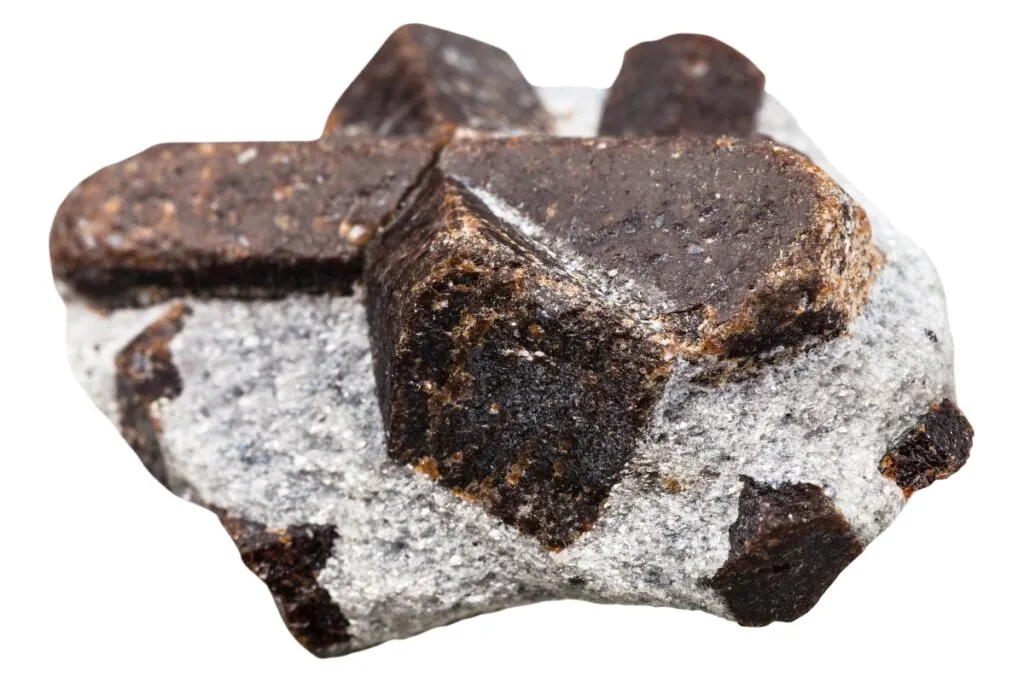
| Location | GPS Coordinates |
|---|---|
| Indian River Shores | 27.736304, -80.392667 |
| Tampa Bay | 27.914588, -82.531542 |
| Clearwater Beach | 27.986464, -82.828534 |
| Santa Rosa Beach | 30.396143, -86.230077 |
| Bradford County | 29.959193, -82.058026 |
| Redfish Cove | 26.546182, -81.965290 |
| St Johns County | 26.546182, -81.965290 |
One of the most interesting minerals that Florida has to offer is staurolite. Staurolite, also referred to as “fairy cross,” forms in the shape of a cross, and intertwined crosses are highly sought-after by collectors.
This mineral forms during the high-pressure process that creates Florida’s sedimentary rocks, and it’s composed of iron-aluminum silicate. Unfortunately, removing staurolite from Florida’s sedimentary rocks is difficult without damaging the shape, so if you decide to do so, use caution!
If you want to add Florida staurolite to your collection, look near Clearwater Beach, Santa Rosa Beach, or Tampa Bay. A few other popular locations for staurolite include St Johns County, Bradford County, and Redfish Cove.
Dolomite
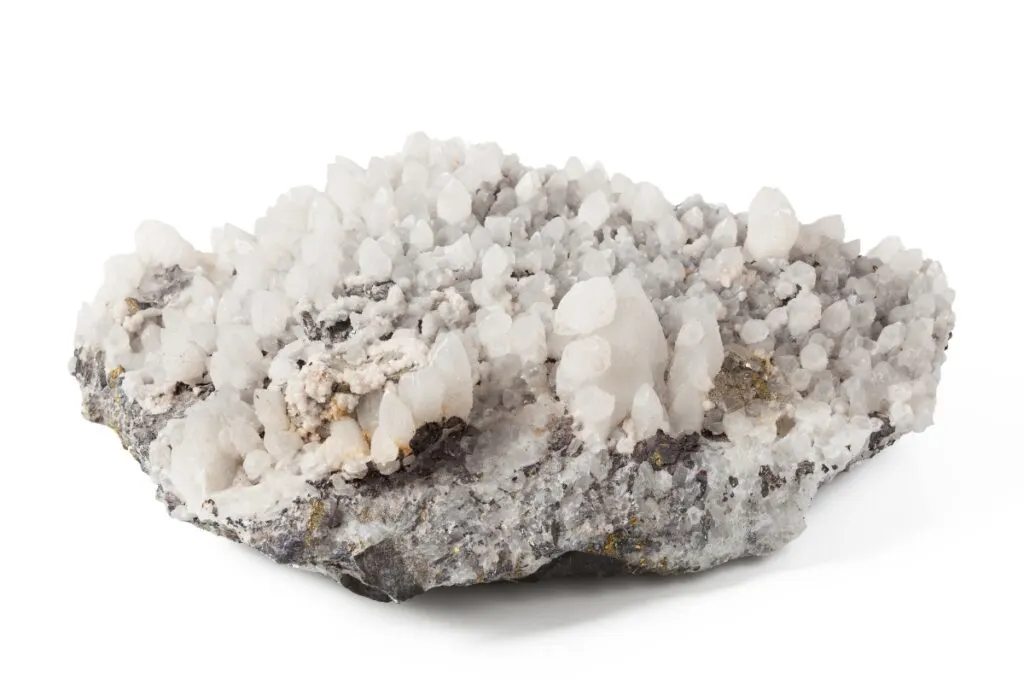
| Location | GPS Coordinates |
|---|---|
| Pompano Beach | 26.233107, -80.090083 |
| Citrus County | 28.920340, -82.582163 |
| Suwannee River | 29.936870, -82.936825 |
| Hardee County | 27.484880, -81.824727 |
| Manatee County | 27.486839, -82.352855 |
| Crystal River Quarries (surrounding areas) | 28.967294, -82.638789 |
| Hillsboro County | 28.038794, -82.300194 |
There are many plants that thrive in Florida due to the warm climate and soil, and one of the main minerals in the soil that supports these plants is dolomite. In the Sunshine State, dolomite is usually white in color, but it can also appear with pink or brown crystals.
Since the 1800s, businesses have mined dolomite from various areas of the state, yet there is still plenty left for rockhounds to collect.
You won’t need to go out of your way to find dolomite in Florida during your rockhounding travels. Since dolomite is so common, you can find it almost anywhere in Florida, but it’s especially abundant in Citrus County, Hillsboro County, and Manatee County.
TIP: Geologists classify minerals based on various common characteristics depending on the sphere of geology in which the classification is used. Find out more in the article below:
How to Guide: Classification of Minerals by PRO Geologist
Zircon
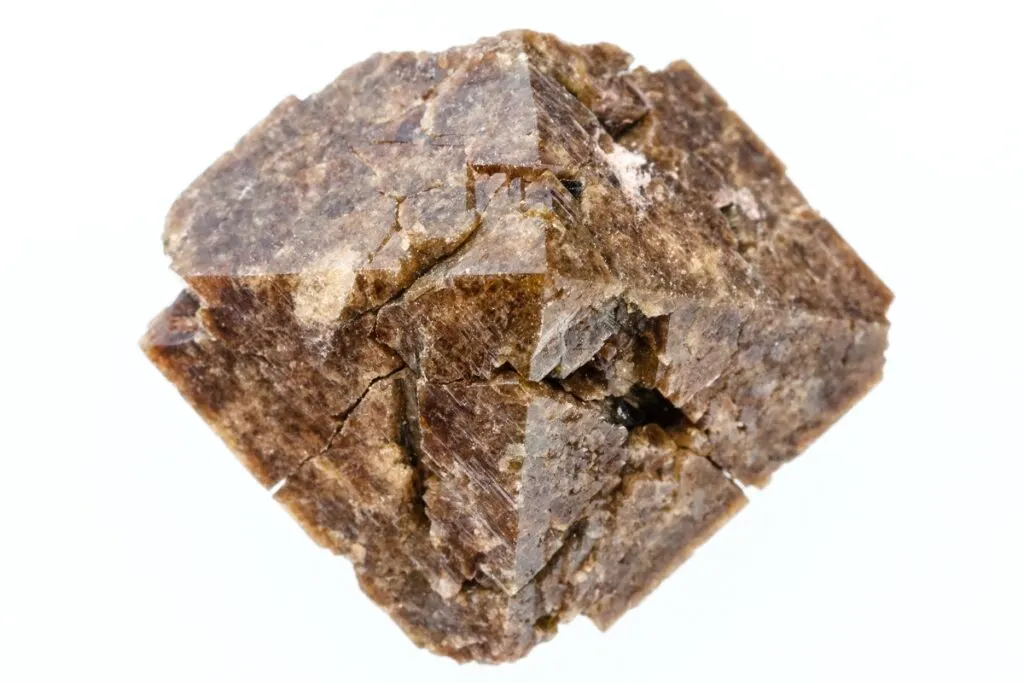
| Location | GPS Coordinates |
|---|---|
| Suwannee River | 29.936870, -82.936825 |
| Tampa Bay | 27.914588, -82.531542 |
| Cape Canaveral | 28.397140, -80.594746 |
| Amelia Island | 30.584111, -81.446779 |
| Lawtey | 30.041366, -82.070251 |
| Jacksonville | 30.352872, -81.784789 |
| Nassau County | 30.616239, -81.804146 |
With its alluring shine, it’s easy to see why zircon is a popular mineral for Florida rockhounds. It’s true that zircon often appears clear, but Florida varieties come in a range of colors, such as red, brown, blue, and even lavender.
Since zircon is commonly found near water, the best places to look in Florida include riverbeds and the coasts.
Without a doubt, Tampa Bay, Cape Canaveral, and the Suwannee River should be your first stops for zircon in Florida. If you can’t make it to those areas, Jacksonville and Nassau County are other great locations as well.
Pyrite
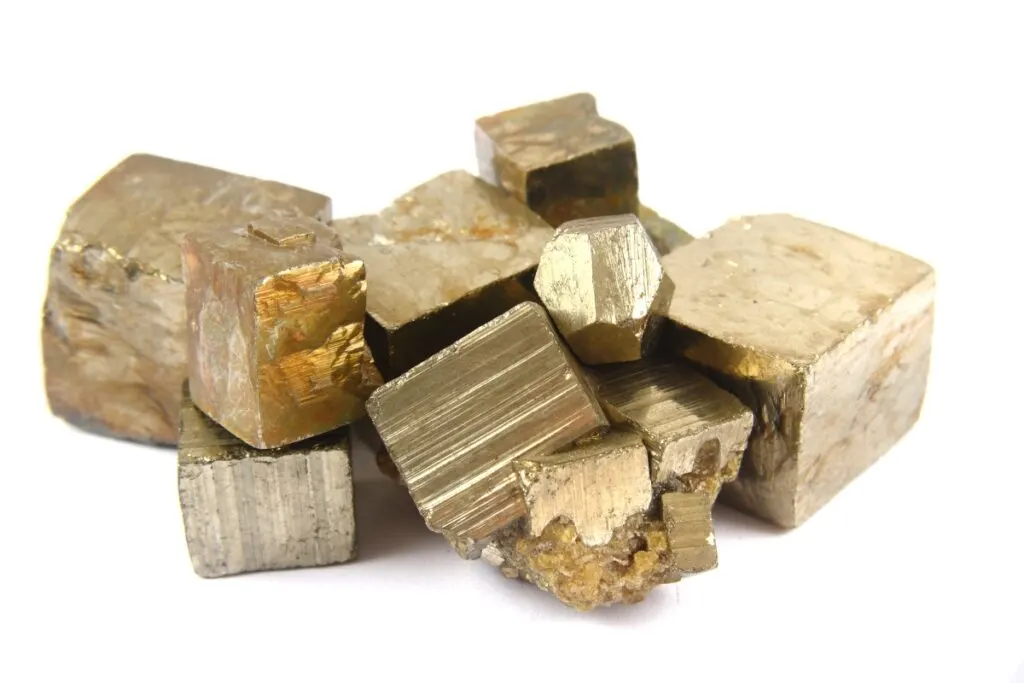
| Location | GPS Coordinates |
|---|---|
| Ocala | 29.216063, -82.165735 |
| Peace River | 27.409987, -81.854448 |
| Homeland | 27.816907, -81.830885 |
| Sebring | 27.506762, -81.464858 |
| Citrus County | 28.932359, -82.615123 |
| Suwannee River | 29.936870, -82.936825 |
| Jackson County | 30.823833, -85.211268 |
If you find a yellowish-gold mineral that glitters, you might be tempted to think it’s gold. Sadly, Florida is a poor state to prospect for gold, so there’s a high chance that what you found is pyrite. Small amounts of gold have been found in northern Florida, but it is extremely rare.
While pyrite might not be as valuable as gold, it’s a lovely mineral that sparkles brilliantly in the sunlight, and Florida is full of it. Rockhounds usually find pyrite embedded in limestone or mixed in with other rocks in the Sunshine State.
As you search for Florida pyrite, check near Ocala, the Peace River, and the Suwannee River before moving on to larger counties, such as Citrus or Jackson.
TIP: Pyrite value can vary dramatically depending on the types of samples. Find out more about pyrites’ value in the article below:
Pyrite Value: Main Factors & Prices for Different Units
FAQ About Common Rocks & Minerals in Florida
The following FAQs are for any curious rockhounds who want to learn more about the common rocks and minerals in Florida, which include:
What Rare Rocks Can You Find in Florida
Fortunately, Florida has many rare rocks for rockhounds to collect, including geodes, agatized coral, petrified wood, and even fossilized pearls. While geodes and petrified wood can be found in other U.S. states, Florida is one of the few with agatized coral and fossilized pearls.
Florida’s fossilized pearls are created when aragonite is replaced with calcite, and they are extremely rare. Agatized coral is more common in the Sunshine State, and it’s Florida’s state stone.
The best places to find rare rocks in Florida are usually the rivers and beaches. To add some rare rocks to your collection, check out the Suwannee River, the Santa Fe River, and the Peace River.
What Rare Minerals Can You Find in Florida
During your Florida rockhounding adventures, watch for rare minerals such as carnelian, moonstone, citrine, kyanite, staurolite, opal, and pearls.
Although some people claim that gold can be found in Florida, it’s extremely rare. There’s a higher chance of finding lost treasure chests with gold coins and bars in Florida than natural gold.
Most traveling rockhounds prefer to find multiple minerals from a single location, and luckily, there are a few sites in Florida that offer this.
Tampa Bay, the Suwannee River, and Ocala are the best places for rockhounds who want to find rare minerals in the Sunshine State. These locations are also excellent sites for fossils, so if you enjoy finding fossilized marine life, you’re in luck!
What is the Most Famous Rock or Mineral Found in Florida
Agatized coral is a rarity that few rockhounds have been able to collect, but if you visit Florida, you’re in luck! Agatized coral is the most famous rock found in Florida, and it was nominated as Florida’s state stone in 1979.
Known for its exceptional beauty and shape, agatized coral retains the shape of coral but is filled with colorful agate.
In Florida, these fossils display red, white, grey, brown, blue, black, or yellow colors. There are many types of coral that can create agatized coral, but the species of coral for Florida’s state stone is Montastrea.
Although rockhounds typically visit the Withlacoochee River for agatized coral, pieces have recently been found near the Suwannee River, so be sure to look there if you’re nearby. Some other popular places to search for this rock include the Econfina River, the Santa Fe River, and Tampa Bay.
BTW: If you are looking for the best UV light for rockhounding, find out my picks below (Amazon links):
- BEST OPTION: Convoy 8+ 365nm UV LED Flashlight with Patented Glass Filter
- BUDGET OPTION: Karrong Rechargeable 1200 Lumen 395nm UV Flashlight
- OPTION FOR INDOOR USAGE: Prime Upgraded Big Chip 396nm UV
Conclusion
For rockhounds, Florida offers much more than tropical scenery and perfect weather. Agatized coral, fossilized pearls, staurolite, coquina, kyanite, and more make a rockhounding trip to Florida worth your time.
During your travels, you might come across carnelian and citrine, or maybe you will be one of the chosen few to find gold in this state.
With Florida’s wide array of rocks and minerals, you never know what you’ll find. Whether you visit Tampa Bay or the Suwannee River, you’re bound to encounter many fascinating rocks and minerals that would make any rockhound jump for joy.
TIP: This sunshine state is rich in rocks, minerals, and fossils – making it a rockhound’s dream. Find out the complete guide on rockhounding in Florida below:
Where to Rockhound in Florida (and What You Can Find)
